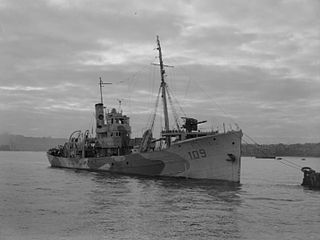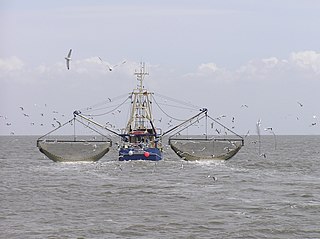HMT Cambridgeshire (FY142) was a British Second World War anti-submarine trawler of the British Royal Navy, named after Cambridgeshire, an English county.

HMAS Kanimbla was a passenger ship converted for use as an armed merchant cruiser and landing ship infantry during World War II. Built during the mid-1930s as the passenger liner MV Kanimbla for McIlwraith McEachern Limited, the ship operated in Australian waters until 1939, when she was requisitioned for military service, converted into an armed merchant cruiser, and commissioned in the Royal Navy as HMS Kanimbla.
HMT Warwick Deeping (H136) was a naval trawler of the British Royal Naval Patrol Service during World War II, sunk off the Isle of Wight in December 1940.

HMT Lord Hailsham (FY109) was a Royal Navy vessel that saw service in World War II. The ship was named after Lord Hailsham.

HM Trawler Force was a British trawler built for the Royal Navy in the First World War and subsequently requisitioned for service in the Second World War. She was sunk by air attack in June 1941.

The Royal Naval Patrol Service (RNPS) was a branch of the Royal Navy active during both the First and Second World Wars. The RNPS operated many small auxiliary vessels such as naval trawlers for anti-submarine and minesweeping operations to protect coastal Britain and convoys.
This is an accounting of the naval trawlers, purpose built or requisitioned, operated by the Royal Navy mainly during World War I and World War II. Vessels purpose built to Admiralty specifications for RN use were known as Admiralty trawlers. All trawlers operated by RN, regardless of origin, were typically given the prefix HMT, which stood for "His Majesty's Trawler".
This ship was originally a fishing trawler launched on 24 March 1936. She was requisitioned by the Royal Navy upon the outbreak of the Second World War in 1939 and designated HMT Lord Middleton with the pennant number (FY219).
HMT Bedfordshire (FY141) was an armed naval trawler in the service of the Royal Naval Patrol Service during World War II. Transferred to the East Coast of the United States to assist the United States Navy with anti-submarine patrols, she was staffed by a British and Canadian crew. Bedfordshire was sunk by the German submarine U-558 on 11 May 1942 off the coast of Ocracoke Island in the Outer Banks of North Carolina, with the loss of all hands.
HMT Vizalma was an anti-submarine warfare naval trawler of the Royal Navy during the Second World War. She spent the war escorting convoys in the Atlantic and Arctic, including the famous convoy JW 51B.
Glen Strathallan was a British ship originally built as a trawler, but then converted into a private yacht, which also served in the Royal Navy in World War II. She was finally scuttled in 1970 at Plymouth Sound, England as a diver training site.
HMT Elk was a 181-ton former fishing trawler built in 1902. She served in the Royal Navy in World War II, until sunk without loss of life having hit a mine off Plymouth in November 1940.

A naval drifter is a boat built along the lines of a commercial fishing drifter but fitted out for naval purposes. The use of naval drifters is paralleled by the use of naval trawlers.

HMAS Goorangai was a 223-ton auxiliary minesweeper of the Royal Australian Navy (RAN). She was built in 1919 for the Government of New South Wales, then sold in 1926 to the fishing company Cam & Sons. The trawler was requisitioned for military service following the outbreak of World War II, converted into a minesweeper, and assigned to Melbourne. She was sunk in an accidental collision with MV Duntroon in 1940, becoming the RAN's first loss of World War II, and the first RAN surface ship to be lost in wartime.

HMS Lady Shirley (T464), also known as HMT Lady Shirley, was a fishing trawler requisitioned by the Royal Navy in 1940 and converted for anti-submarine warfare duties. She sank U-111 on 4 October 1941, capturing 44 of her crew. Lady Shirley was sunk herself on 11 December 1941, by a single torpedo from U-374
Davara was a British steam trawler during World War II that was sunk by the German submarine U-27. On 6 January 1912, the ship was launched from Selby by the shipbuilding company Cochrane & Sons Ltd. The ship's owner, Mount Steam Fishing Co Ltd. christened her Davara. By March 1912, the trawler was registered and completed and in 1914 she was requisitioned by the British Royal Navy for service in World War I and fitted out for mine sweeping activities. Having survived World War I, she was returned to her owners in 1919 and served as a trawler once more until 13 September 1939 when she was sunk by 35 rounds from U-27's main deck gun. The 12 man crew managed to escape the submarine in a lifeboat while the Davara later sunk at 14:55 from the damage inflicted by U-27's gunfire. Her crew remained in the water "baling and rowing" for five hours before they were picked up by the steamer Willowpool and safely made landfall. Davara was the first British trawler to be sunk by enemy action in World War II.

The terms Allied Chinese Ships and Allied China Fleet refer to 32 vessels of the Hong Kong-based China Navigation Company requisitioned by the Royal Navy and the Royal Australian Navy during World War II. Following the Battle of Singapore in early 1942, many of the requisitioned ships joined the Allied retreat to Australia. Six were acquired by the Royal Australian Navy; four of these were commissioned as auxiliary warships, while two served as Victualing Supply Issuing Ships.
The following index is provided as an overview of and topical guide to recreational dive sites:















